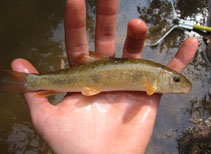http://www.fishbase.org/Summary/speciesSummary.php?genusname=Catostomus&speciesname=commersonii ---> http://192.134.151.83/Summary/speciesSummary.php?genusname=Catostomus&speciesname=commersonii
http://192.134.151.83/Summary/speciesSummary.php?genusname=Catostomus&speciesname=commersonii ---> https://fishbase.mnhn.fr/Summary/speciesSummary.php?genusname=Catostomus&speciesname=commersonii
https://fishbase.mnhn.fr/Summary/speciesSummary.php?genusname=Catostomus&speciesname=commersonii ---> https://fishbase.mnhn.fr/summary/Catostomus-commersonii.html
Catostomus commersonii, White sucker : fisheries, aquaculture, gamefish, bait

You can
sponsor
this page
Common name (e.g. trout)
Genus + Species (e.g. Gadus morhua)
-

-
About this page
-
Languages
-
User feedbacks
-
Citation
-
Uploads
-
Related species
-


 White sucker
Upload your
photos
and
videos
White sucker
Upload your
photos
and
videos
Pictures
|
Google image
 Catostomus commersonii
Catostomus commersonii
Picture by
Seelig, C.
Teleostei (teleosts) >
Cypriniformes
(Carps) >
Catostomidae
(Suckers) > Catostominae
Etymology:
Catostomus:
Greek, kata = down + Greek, stoma = mouth (Ref.
45335
)
;
commersonii:
Named after P. Commerson, early french naturalist.
.
More on author:
Lacepède
.
Environment: milieu / climate zone / depth range / distribution range
Ecology
Freshwater; brackish; demersal, usually ? - 30 m (Ref.
1998
). Temperate; 0°C - 29°C (Ref.
35682
); 68°N - 34°N
North America: throughout most of Canada to the Atlantic Coast, south through North Carolina to New Mexico in the USA, becoming less common in the southern High Plains.
Length at first maturity / Size / Weight / Age
Maturity: L
m
?
, range 23 - ? cm
Max length : 65.0 cm TL male/unsexed; (Ref.
10294
); common length : 40.7 cm TL male/unsexed; (Ref.
12193
); max. published weight: 2.9 kg (Ref.
4699
); max. reported age: 12 years (Ref.
12193
)
Inhabits a wide range of habitats, from rocky pools and riffles of headwaters to large lakes. Usually occurs in small, clear, cool creeks and small to medium rivers. May be found at a depth greater than 45 m (Ref.
1998
). Moves to shallower water near sunrise and sunset to feed. Fry (1.2 cm in length) feed on plankton and other small invertebrates; bottom feeding commences upon reaching a length of 1.6-1.8 cm. Preyed upon by birds, fishes, lamprey, and mammals (Ref.
1998
). Flesh is white, flaky, and sweet (Ref.
1998
).
Adults home to certain gravelly spawning streams. Two to four males crowd around a female and press against her with their fins. Eggs are scattered and adhere to the gravel or are carried downstream and adhere to the substrate when the water is calmer. The spawning act lasts for 3-4 seconds and may occur 6-40 times an hour (Ref.
1998
). Spent adults return to the lake 10-14 days after spawning began. Most females return to the lake during the first half of the downstream migration followed by most males in the latter half. Downstream fry migration occurs between dusk and dawn (Ref.
10928
).
Page, L.M. and B.M. Burr
, 1991. A field guide to freshwater fishes of North America north of Mexico. Houghton Mifflin Company, Boston. 432 p. (Ref.
5723
)
IUCN Red List Status (Ref.
130435
)
Least Concern (LC)
; Date assessed:
26 October 2011
CITES
Not Evaluated
Not Evaluated
Threat to humans
Harmless
Human uses
Fisheries: minor commercial; aquaculture: commercial; gamefish: yes; bait: occasionally
FAO - Publication:
search
|
FishSource
|
More information
Countries
FAO areas
Ecosystems
Occurrences
Introductions
Stocks
Ecology
Diet
Food items
Food consumption
Ration
Common names
Synonyms
Metabolism
Predators
Ecotoxicology
Reproduction
Maturity
Spawning
Spawning aggregation
Fecundity
Eggs
Egg development
Age/Size
Growth
Length-weight
Length-length
Length-frequencies
Morphometrics
Morphology
Larvae
Larval dynamics
Recruitment
Abundance
BRUVS
References
Aquaculture
Aquaculture profile
Strains
Genetics
Electrophoreses
Heritability
Diseases
Processing
Nutrients
Mass conversion
Collaborators
Pictures
Stamps, Coins Misc.
Sounds
Ciguatera
Speed
Swim. type
Gill area
Otoliths
Brains
Vision
Tools
E-book
|
Field guide
|
Identification keys
|
Length-frequency wizard
|
Life-history tool
|
Point map
|
Classification Tree
|
Catch-MSY
|
Special reports
Check for Aquarium maintenance
|
Check for Species Fact Sheets
|
Check for Aquaculture Fact Sheets
Download XML
Summary page
|
Point data
|
Common names
|
Photos
Internet sources
AFORO (otoliths) |
Alien/Invasive Species database
|
Aquatic Commons
|
BHL
|
Cloffa
|
BOLDSystems
|
Websites from users
|
Check FishWatcher
|
CISTI
|
Catalog of Fishes
:
genus
,
species
|
DiscoverLife
|
ECOTOX
| FAO - Publication:
search
|
Faunafri
| Fishipedia |
Fishtrace
| GenBank:
genome
,
nucleotide
|
GloBI
|
Google Books
|
Google Scholar
|
Google
|
IGFA World Record
|
MitoFish
|
Otolith Atlas of Taiwan Fishes
|
PubMed
| Reef Life Survey | Socotra Atlas |
Tree of Life
| Wikipedia:
Go
,
Search
| World Records Freshwater Fishing |
Zoological Record
Estimates based on models
Phylogenetic diversity index (Ref.
82804
): PD
50
= 0.5000 [Uniqueness, from 0.5 = low to 2.0 = high].
Bayesian length-weight: a=0.01259 (0.00986 - 0.01608), b=2.99 (2.92 - 3.06), in cm total length, based on LWR estimates for this species (Ref.
93245
).
Trophic level (Ref.
69278
): 2.8 ±0.2 se; based on diet studies.
Generation time: 8.5 ( na - na) years. Estimated as median ln(3)/K based on 2
growth studies.
Resilience (Ref.
120179
): Low, minimum population doubling time 4.5 - 14 years (tm=6; tmax=12).
Fishing Vulnerability (Ref.
59153
): High vulnerability (57 of 100).
Price category (Ref.
80766
):
Unknown
.
Nutrients (Ref.
124155
): Calcium = 52.1 [25.3, 83.6] mg/100g; Iron = 0.403 [0.252, 0.694] mg/100g; Protein = 16.6 [14.4, 19.2] %; Omega3 = 0.736 [0.374, 1.461] g/100g; Selenium = 14.8 [8.2, 28.1] μg/100g; VitaminA = 11.4 [4.2, 29.5] μg/100g; Zinc = 0.696 [0.520, 0.964] mg/100g (wet weight); based on
nutrient studies.
Back to Search
Random Species
Back to Top
Accessed through:
Not available
FishBase mirror site :
localhost
Page last modified by :
mrius-barile
- 20 July 2016
Fatal error
: Uncaught ArgumentCountError: Too few arguments to function checkEcotox(), 1 passed in /var/www/html/summary/speciessummary.php on line 2304 and exactly 3 expected in /var/www/html/includes/speciessummary.lib.php:2579 Stack trace: #0 /var/www/html/summary/speciessummary.php(2304): checkEcotox() #1 {main} thrown in
/var/www/html/includes/speciessummary.lib.php
on line
2579
|